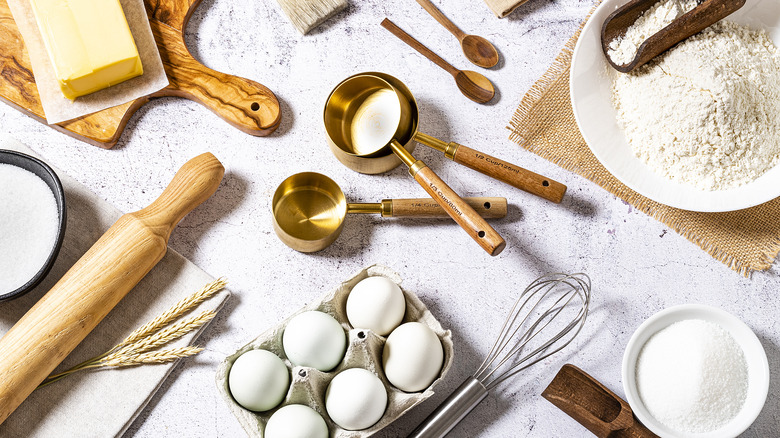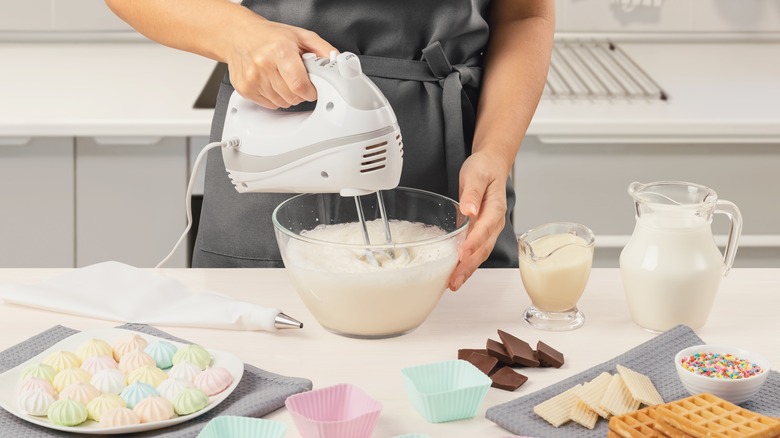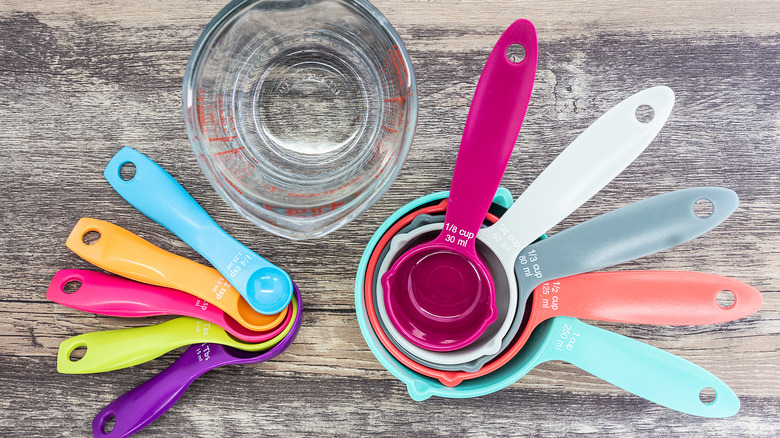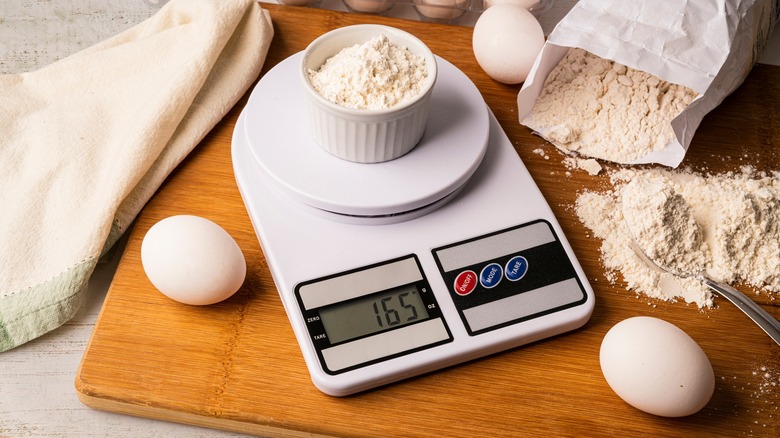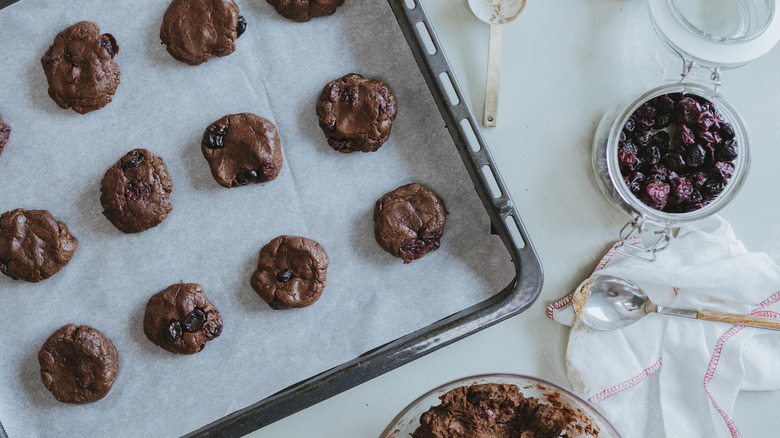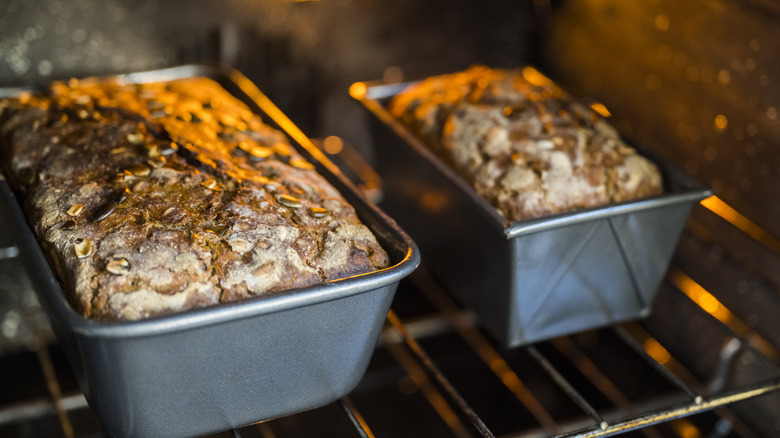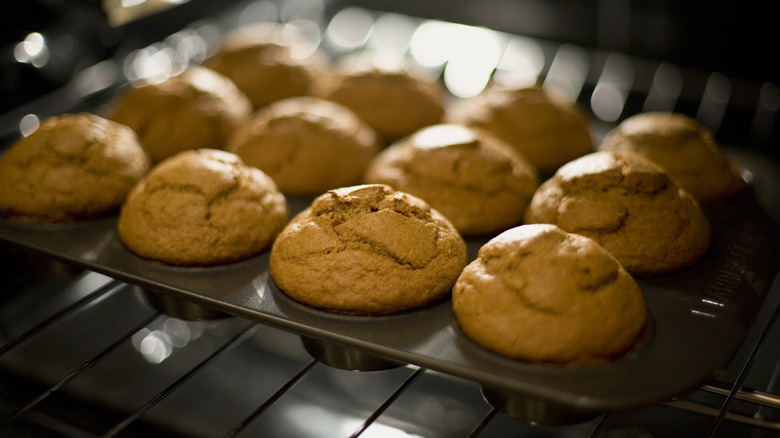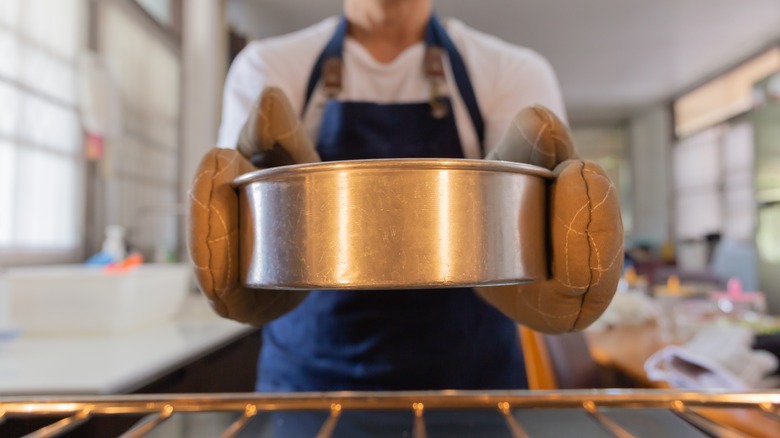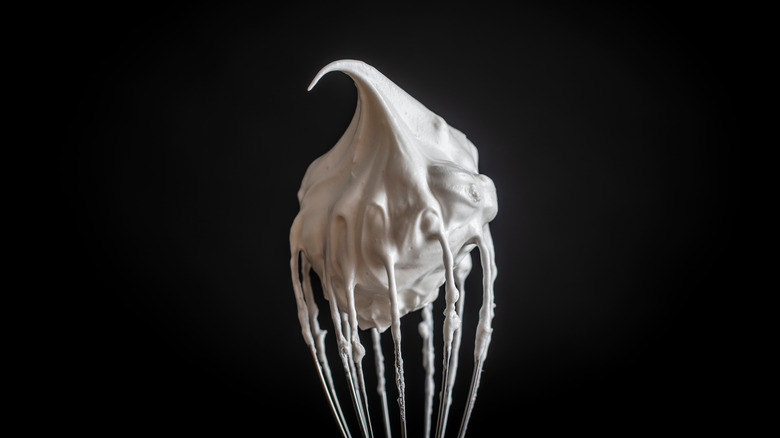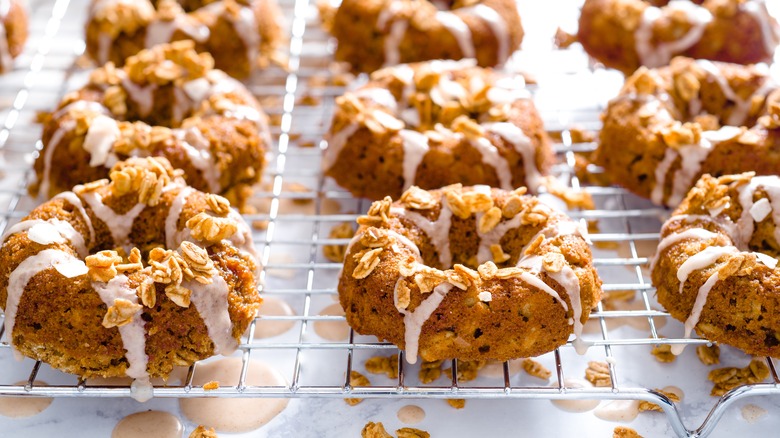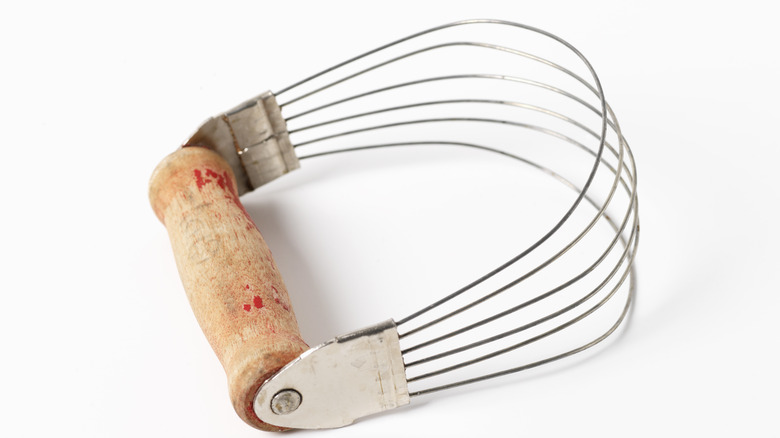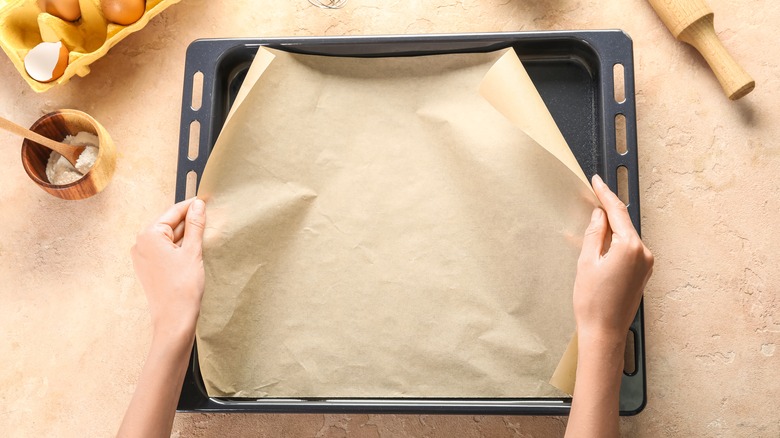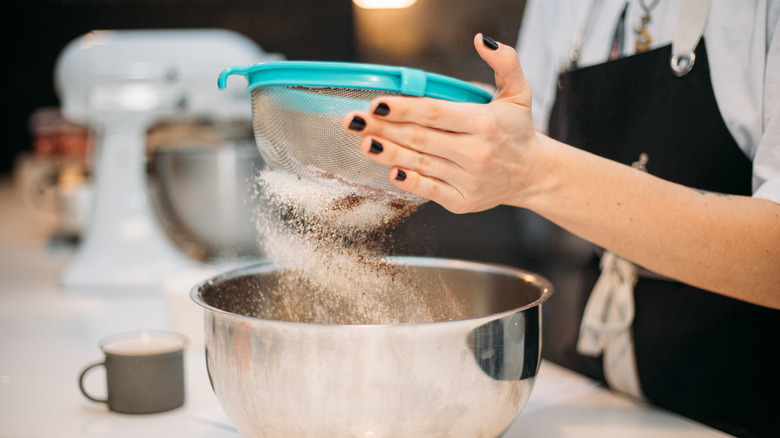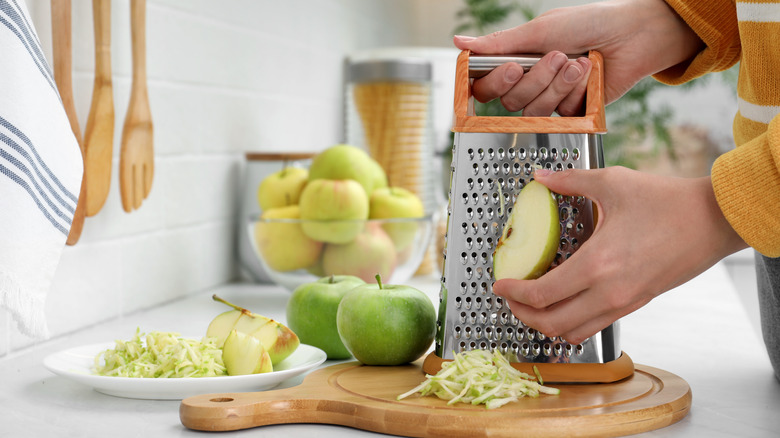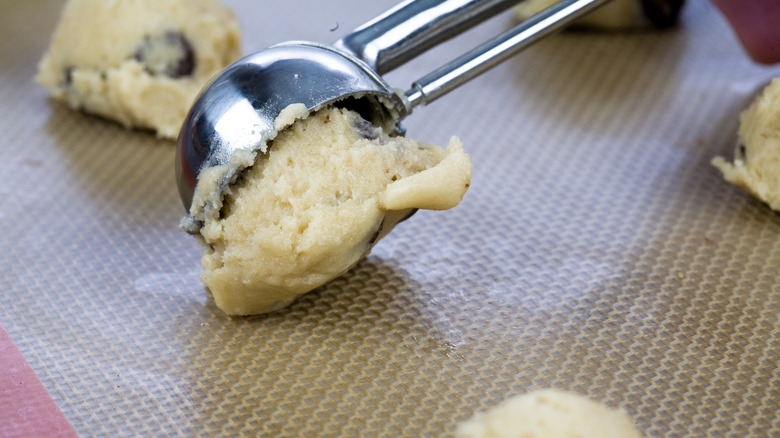A Guide To The Essential Baking Tools Everyone Should Own
We may receive a commission on purchases made from links.
If you've watched any of the wide variety of baking competitions on TV, you have some idea of what it takes to bake something successful. And while the average home baker certainly isn't whipping up carefully decorated wedding cakes in their day-to-day, there is still quite a bit of preparation that goes into the process, and it begins with the tools.
From beginner bakers to experts, there are some things that you just need regardless of your baking level. Below you'll find a list of items that we have deemed baking essentials, from the most basic items to some you may have never thought of. If there's one tip that we can give you, it's to make sure you are prepared before diving headfirst into any recipes, and this guide is here to do just that. Whether you've been eyeing a special recipe, or are simply looking to get started on your baking journey, we're here to tell you that this is your sign to do it.
Electric mixer
If there is one thing that will change the baking game for you, it's an electric mixer. If you've ever followed a recipe instructing you to mix ingredients with an electric mixer, you know how crucial this tool can be. It may be true that mixing by hand can do the job, but there are some instances where the hand mixer does more than just spare you an arm workout and is required for the recipe.
While a KitchenAid is certainly the dream, simple hand mixers work perfectly fine with several different attachments for different purposes. Whether it's creaming your butter and sugar, whipping up egg whites, or kneading dough, there are a million ways that an electric mixer makes baking easier, but more importantly, ensures the recipe is a success.
Measuring cups
This may be getting granular, but measuring cups are an essential tool for baking. While we're all for creativity in the kitchen, baking is less forgiving when it comes to precise measurements. Recipes will specify everything by cup measurements, and will often note whether the cup should be tightly packed or carefully filled with a spoon. Regardless, it's often a best practice to spoon in your ingredients to ensure that it's level and the measurement is accurate.
Don't forget your tablespoons and teaspoons, which should be included in most measuring cup sets. These tiny tools are essential for the finer details – baking soda, baking powder, salt, and plenty of other seasonings are often added in small portions but make a huge difference when measured incorrectly.
Mixing bowls
A solid set of mixing bowls will get you far in the kitchen, and yes we mean mixing bowls plural. Plenty of recipes may be doable in one bowl, but most will call for a separation of wet and dry ingredients before combining the two, so you'll want a variety of bowls that come in different sizes.
If you're wondering why you can't just use any normal serving bowls, we're here to tell you why. A mixing bowl will have the depth that is critical for baking, especially when dealing with ingredients like flour. Furthermore, when using your hand or electric mixer, a stainless steel mixing bowl won't be damaged by the rapid motions of the mixer's attachments. If you want to get fancy, find a set of mixing bowls that have silicon bottoms. This will ensure that your bowls will stick to the counter while you're mixing.
Digital scale
Many in the baking community will tell you that the best, and most accurate, way to measure for baking is by forgoing cup measurements and using a digital scale. More basic recipes may be forgiving when it comes to measurements. However, when it comes to more complex creations, the scale is critical for getting the right amount of key ingredients – namely flour.
A cup of packed flour can vary in weight depending on how it is packed, which is why a digital scale is necessary to measure flour properly. Recipes will almost always include measurements in grams, the precise amount of each ingredient. Simply weigh out the ingredients in a mixing bowl, making sure to zero out your scale once the bowl is on there. For all of our perfectionists out there, if you don't already, add a digital scale to your baking necessities.
Rolling pin
Put the glass bottle down, and go buy a rolling pin for your next baking project. Despite what the internet may say, there is no real replacement for a rolling pin in baking. If you're thinking of baking bread in the near future, make sure that you have this essential tool first. This goes for any recipe that requires the dough to be smoothed out before shaping and baking, including everyone's favorite pastry — cinnamon rolls.
Depending on the material of your rolling pin, your dough may stick to the surface of the pin while rolling it out. To avoid this, use as much flour as needed to coat your flat surface and the rolling pin. If you're thinking that this baking tool is only good for one thing, there are plenty of other uses for a rolling pin in the kitchen that will make this purchase worthwhile.
Baking trays
While there are plenty of tools that are essential in the prep phase of baking, there are a few critical items needed for the actual baking. One of those items are baking trays, flat surfaces for your baked goods to rest on in the oven. Big aluminum trays are perfect for baking any number of goods, from cookies to scones.
Aluminum is preferred for baking due to it being relatively indestructible, and retaining heat at a rate that is more conducive for an even bake than a material like glass. Pay attention to recipe instructions for tray prep, which often involves lining the tray with parchment paper or foil to avoid a sticky mess. Even nonstick pans can build up residue over time, so make sure to clean your baking sheets after each use.
Loaf pans
Baking trays can open an entirely new can of worms as we get into more niche baking. Of course, as you expand your baking repertoire, you'll find that some niche bakes require more specific pans for different shapes and baked goods. One staple pan that you'll find comes in handy is a basic loaf pan, which is used for a vast number of bread recipes.
Quick bread and sweet loaves are some of the most simple, beginner-friendly recipes out there. Don't get us wrong — these recipes still require high attention to detail but often require fewer steps and overall prep time. However, these aren't possible without a tin for your loaf to bake in. The standard size for these pans is 9x5 inches. You can often find single-use foil tins at your local grocery store, but we recommend buying a reusable metal pan to keep in your kitchen.
Muffin tins
Next up on our list of specialty pans is a muffin tray, or a cupcake tray, depending on the occasion. There's no getting around it – these tins are essential to muffin recipes to give your baked goods a uniform shape and an even bake. Muffin recipes, similar to loaves, are relatively simple to whip up and are the perfect thing to make quickly for any occasion.
Using a muffin tin to make cupcakes is a great way to practice achieving the perfectly moist cake consistency on a smaller scale before moving onto cakes. There are tons of recipes out there to get creative with your muffins and cupcakes, so make sure to pick up a muffin tin next time you're at the store and get baking!
Cake pans
Not everyone can become a cake boss overnight – it takes time, practice, and most importantly, the right baking tools. It should go without saying that cake pans are essential to your cake-making success. Whether it's round or square, you'll want a set of pans so you can bake each layer at once. Even if you're a novice baker, at least two layers is a good place to start for even a classic white cake.
Cake pans can come in other shapes, too, if you're ready to take the leap into specialty cake pans. A prime example of this is bundt pans, used to perfectly shape bundt cakes. When baking with any of the above, you'll want to make sure that each pan is properly greased (even if it is a non-stick pan) so that your cakes can easily slide out without any fuss.
Spatulas and whisks
This may go without saying, but handheld mixing tools are an absolute must. Electric hand mixer aside, there's some manual work that will always go into baking. First up, whisks which serve a multitude of purposes. We prefer a metal balloon whisk, which can be used for beating eggs, mixing and combining dry ingredients, and whipping cream – you name it.
Spatulas are another tool that any baker can't live without. If a recipe ever tells you to incorporate or gently fold in ingredients, that is your cue to use a spatula. Specifically, rubber spatulas are handy for scraping pans and getting into the tiniest crevices to make sure nothing is wasted. Sure, forks and spoons might do the trick, but we're here to make baking easier with these mixing tools.
Cooling rack
A cooling rack may not be the first thing that comes to mind when it comes to baking, but is certainly an underrated and important tool. A metal wire cooling rack, while it really only serves one purpose, serves a critical one. For the most part, you'll want to remove whatever you have baked from its pan once it has finished cooking for the desired oven time. Otherwise, you risk your bake being overdone since it may keep cooking in the metal pan even after it has been removed from the oven.
This is where a cooling rack comes in handy, as the perfect place to rest your baked goods as they cool and settle. If placed over a plate, a cooling rack is also a great tool to use for icing a cake or any other tasty dessert. It allows you to get as messy as necessary while catching all of the excess without a hassle.
Pastry cutter
A pastry cutter is another semi-irreplaceable item when it comes to baking. These u-shaped, handheld devices are perfect for cutting cold butter into flour, which sounds oddly specific, but is something most bakers are very familiar with. Puff pastries and other flaky-dough-based goodies like pies and biscuits are made by cutting cold butter to mix into the flour, which is where this tool comes into play.
Some recipes may say that you can just use your hands, but the warmth from your touch risks melting the butter just enough to make your life difficult. The shape of the pastry cutter, along with its dull metal blades, makes it easy to cut the butter into small pieces while ensuring it keeps its cool temperature.
Parchment paper
The last thing you want after putting time and effort into a tasty treat is for it to get stuck at the bottom of the pan it's baking in. Despite any pans with non-stick labels, it's always a best practice to be safe and line your trays with parchment paper. You might be wondering why parchment paper, or the differences between parchment paper and wax paper or aluminum foil.
Parchment paper is the most versatile, and able to handle high temperatures that often come with baking. Whether it's cookies on a tray, brownies in a pan, or something else, parchment paper will protect the bottoms of your baked goods from getting too brown — or even burnt. Simply mold your parchment paper in whichever shape you need to fit a pan of any shape and size, and let it work its magic.
Sieve
It seems like there are endless tools to properly measure flour, which should give you the hint that it is pretty important. Clumpy flour is a baker's worst nightmare and could be the reason some of your bakes aren't turning out as expected. Luckily, a sieve is just the tool to fix this problem.
A sieve is just like a colander, only it is fine enough to take clumpy flour and sift through all of those unwanted bunches. If a recipe calls for sifted flour, you'd better hope that you have this tool on hand. As mentioned above, flour is testy when it comes to weight and measurement. A sifted, fine flour ensures that the amount of flour is of the correct quantity and quality.
Grater
If you own a cheese grader at home, then you may already be in luck with this baking essential. Albeit niche, a grader can come in handy for a variety of recipes that call for graded goods – most often in the form of fruits or vegetables. Think of a moist zucchini bread or carrot cake, both of which are moistened by the finely shredded pieces of vegetables that are folded in.
In a similar vein, a zester is a great tool for flavoring your bakes with citruses like oranges and lemons. Shaving off small particles of skin from these fruits will bring your baking to life with a hint of sweetness and sourness. If you have a box grater with multiple sides, you may notice that one side is finer than the other – this is the side you'll want to use for grating any sort of citrus.
Cookie scoop
Although this tool has cookies in its name, cookie scoops can be used for so much more, and we are all about a multi-functional baking tool. Obviously, a cookie scoop is essential for shaping and scooping the perfect cookie. Chocolate chip, oatmeal raisin, snickerdoodle — the choices are endless. Back to the baking tool, which will ensure that no cookie is made unequal.
If you've ever tried eyeballing the perfect amount of batter for muffins or cupcakes, you'll appreciate this hack that you may or may not already know. A cookie scoop is just another way to make sure every measurement is even, regardless of what is being made. We're sure there are other creative ways to use a cookie scooper, but for now, just trust us on this and add this to your toolbox.
